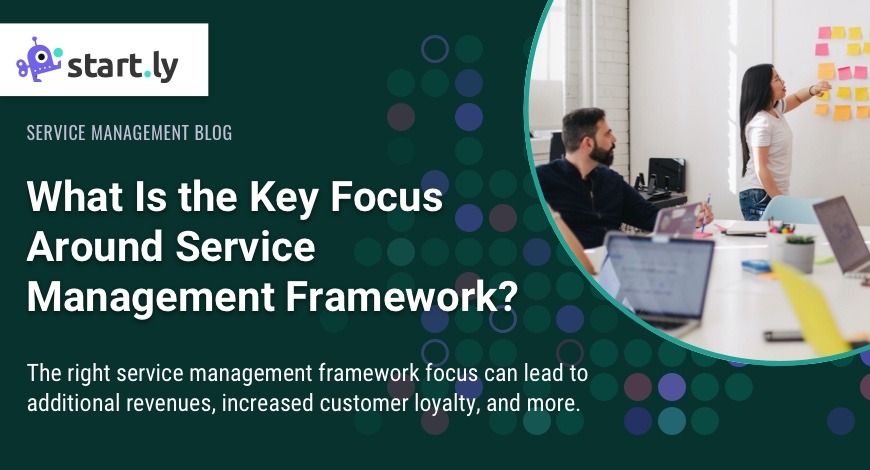Many companies have felt the frustration of having too many platforms for service management. And the more unique a business may strive to be, the more they may find themselves spread across multiple professional and IT service management solutions, stringing together organization and direction as best they can. Fortunately, this is a recognized issue that has led to the development and creation of service management frameworks. Let’s examine what your business should be focusing on in terms of a quality service management framework.
First, What Is Service Management and Why Is It Important?
Service management describes how businesses and organizations provide and manage quality services for their customers. To demonstrate, here are some real world examples of service management:
- A clothing store managing their sales platforms and asset inventory
- An internal IT department tracking help desk ticketing and rolling out infrastructure changes
- A warehouse monitoring integrated tracking codes and statuses of various deliverables
This concept has been developed for decades, providing a rich pool of resources for those looking for a solid service management framework. Why is it important? We can think of a few reasons. A good service management framework can:
- Lower operational costs and boost ROI
- Increase transparency and accountability
- Optimize efficiency by shifting from separate functionalities to an interconnected approach
- Give deeper insight to changing customer needs and pain points
- Enable easy transitions to new or modified processes and technologies
- Provide big-picture views and controls
With this understanding of service management and its importance, let’s take a look at the key focus around service management frameworks.
5 Key Service Management Roles and Responsibilities
What is the primary focus of service management? There really isn’t a good way to answer that. Service management is a complex machine with many moving parts. Information Technology Infrastructure Library (ITIL) is a well-known resource that provides best practices for managing these moving parts, including IT service management (ITSM). Understanding the five ITIL service management processes is an excellent starting point for comprehending how all of these roles and responsibilities work together to achieve primary ITIL objectives.
1. Service Strategy
It is imperative to define your services and their goals clearly before designing a service management framework. Your entire enterprise should have an unambiguous understanding of the vision and overarching mission of the organization’s offered services. When focusing on service strategy, your team should be considering:
- Developing strategic assets
- Determining the audience using your services
- Preparing to deploy services
- Connecting business strategies to IT strategies
- Defining the details of offered services
2. Service Design
With a cohesive service strategy in place, your team can begin to design a service management framework. Service design will vary depending on the exact needs of your audience, but it should be consistent and always work toward improving the overall service.
Those involved in this stage of a service management system will handle things like service catalog management, which involves organizing various service information (e.g. prices, points of contact, ordering, descriptions, etc.). They also monitor capacity management to ensure that company resources are meeting service requirements. When considering the architecture of a service management framework, they must also seek to solve current problems as well as anticipate future ones.
3. Service Transition
This is the stage where an idea becomes a reality. New or modified services must be developed and thoroughly tested before full implementation. After the service is active, the service transition team will continue to monitor for common transitional issues. Throughout each phase of a service management project, service transition will focus on facilitating clear communication for operational needs and work to solve those needs in the constant pursuit of improvement.
4. Service Operation
All the other stages of the ITIL Service Lifecycle so far generally occur behind the scenes. The service operation stage is where your service takes the main stage and begins interacting with your audience. If all procedures were properly followed behind the scenes, your audience will likely be captivated by your service. Common themes of the service operation stage include:
- Incident and service request ticketing
- Management for any resulting events that require intervention
- Planning and implementing solutions for request fulfillment
- Alleviating a wide variety of possible service problems
Our experienced service management team at Startly also provides shipping inventory management, customizable knowledge databases, and ticket lifecycle trends to give our customers a transparent view of their service operations.
5. Continual Service Improvement
Once you have your service up and running, improvement is the final, never ending stage of service management. We say never ending not to be a downer, but to be realistic, as a business should never stop looking for ways to improve a service. The needs of society will change, as will the competition, and a stagnant business environment usually does not equate to a successful one. Using a knowledge base like the one we offer at Startly allows businesses to easily spot and solve customer problems and requests as they arise, facilitating growth and improved business health.
Too Much to Focus On? Let Startly Help!
Do you want to build a loyal customer base that is enthusiastic about your products and services? A thoughtful and robust service management framework is a key to getting you there. With the implementation of Startly’s successful service management solutions, your business stands to gain more meaningful customer communications and feedback, new awareness of changing needs and trends, additional revenues, and more.
Not only does our centralized dashboard provide a quality service management framework, but it also focuses on time and expenses, organizational governance, as well as analytics and insights. We were tired of jumping from software to software and managing services across multiple platforms, so we created a framework where you can do it all in one place. Curious to learn more about Startly’s unique service solutions? Contact us! With Startly, you can generate the freedom and innovation necessary for a promising business future.

